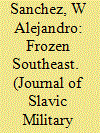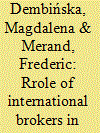| Srl | Item |
| 1 |
ID:
088823


|
|
|
|
|
| Publication |
2009.
|
| Summary/Abstract |
The Republic of Transnistria is a separatist region of the Southeastern European state of Moldova. While not much has changed in this "frozen conflict" since a 1992 short-lived war, the eastwards expansion of the European Union and NATO are slowly bringing Moldova to the attention of Western policymakers. The cornerstone of the separatist cause is the Russian Federation, which serves as Transnistrias protector. Given the 2008 summer in war in Georgia, another so-called "frozen conflict," it is necessary to evaluate how a Russia-backed separatist region in Moldova, accussed of human rights violations and weapons trafficking, fits into the wider discussion of European geosecurity and NATO/West-Russian relations for the immediate future.
|
|
|
|
|
|
|
|
|
|
|
|
|
|
|
|
| 2 |
ID:
163161


|
|
|
|
|
| Summary/Abstract |
The “frozen” conflict between Moldova and its separatist Transnistrian region—which developed into a de facto state—is dynamic. Despite an active nation-building project to support Transnistria’s independence and a stated willingness to join Russia, Transnistria is juggling between Russia and Europe. While economically dependent on the former’s subsidies and security guarantees, Transnistrian economic ties with the West are growing strong. While most studies are interested in the geopolitical game and the role of external actors, this article argues for a complementary approach that links macro- with meso-level analysis through the role of externally oriented domestic agents. First, the article shows that Transnistria pursues dual alignment in order to survive and provide the population with public goods for which they need external resources. Although Transnistria relies heavily on its patron state, Russia, facing recurrent crisis and external constraints, it has to search for complementary sources of income. Dual alignment is the result of this “multiple asymmetric dependence.” Second, the article argues that local intermingled economic and political interests, embodied by businessmen with close ties not only to Russia but also to Europe, account for how this balancing act is sustained. These informal international brokers or “double agents” mobilize their political connections to support dual alignment while using their Western and Eastern business connections to consolidate their power in Transnistria. It is further argued that the role of international brokers embedded in Russian and European networks and engaging in cross-border cooperation helps understand why the Transnistrian frozen conflict seems to be withering
|
|
|
|
|
|
|
|
|
|
|
|
|
|
|
|